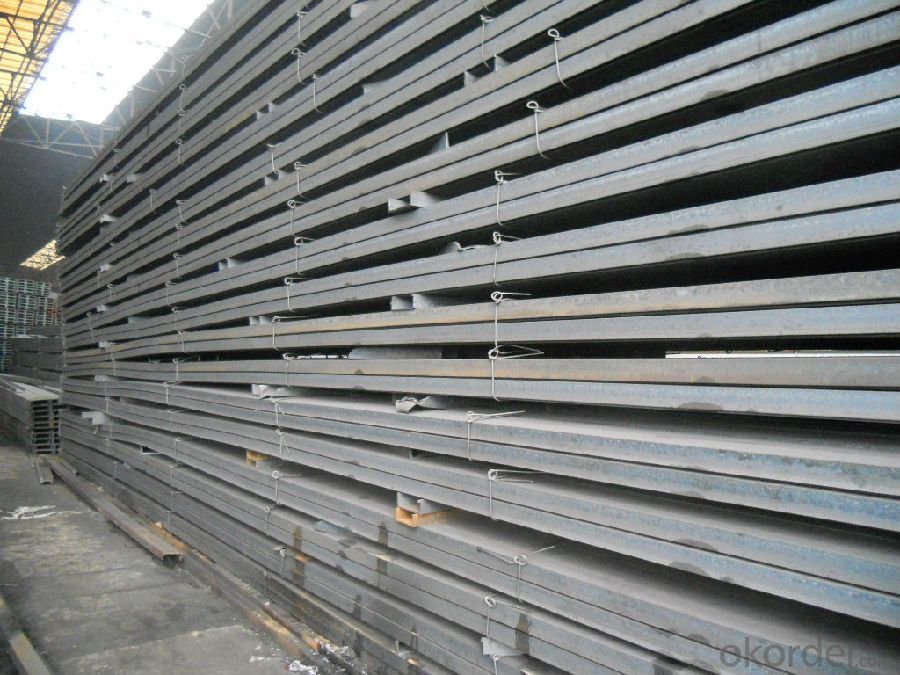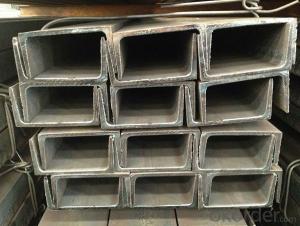Hot Rolled Steel U Channels of JIS Standard for Structures
- Loading Port:
- Guangzhou
- Payment Terms:
- TT OR LC
- Min Order Qty:
- 25 m.t.
- Supply Capability:
- 200000 m.t./month
OKorder Service Pledge
OKorder Financial Service
You Might Also Like
Product Description:
OKorder is offering Hot Rolled Steel U Channels of JIS Standard for Structures at great prices with worldwide shipping. Our supplier is a world-class manufacturer of steel, with our products utilized the world over. OKorder annually supplies products to European, North American and Asian markets. We provide quotations within 24 hours of receiving an inquiry and guarantee competitive prices.
Product Applications:
Hot Rolled Steel U Channels of JIS Standard for Structures are ideal for structural applications and general fabricating. The steel u channel can be applied to construction of warehouses, workshops, sport stadiums and car parks etc. In details, the steel u channel belongs to carbon structural steel which is applied to in the field of construction and machinery. The steel u channel is usually used for arch-itechtural structure, and they could be welded in order to support or hang a vari-ety of facilities. They are also usually used in combination with I beam. Generally,the steel u channel must possess perfect welding property, riveting property and mechanical property and so on.
Product Advantages:
Hot Rolled Steel U Channels of JIS Standard for Structures are durable, strong, and resists corrosion. And the tensile strength and yield point can satisfy the requirements of customers.
Main Product Features:
· Premium quality
· Prompt delivery & seaworthy packing (7-10 days after receiving deposit)
· Corrosion resistance
· Can be recycled and reused
· Mill test certification
· Professional Service
· Competitive pricing
Product Specifications:
Hot Rolled Steel U Channels of JIS Standard for Structures Details:
Minimum Order Quantity: 25 Tons Unit: m.t. Loading Port: Xingang Port
Supply Ability: 1000 Tons Per Day Payment Terms: TT or L/C
Product Description:
Specifications of Steel U Channel:
Standard Applied: GB Standard, EN Standard(UPN), JIS Standard
Sizes: 50mm to 300mm
Material Grade: Q235B, Q345B, S235JR, SS400, ASTM A36
As shown in the figure:
| JIS U CHANNEL | Standard h | Sectional b | Dimension s | t | Mass: Kg/m |
| (mm) | (mm) | (mm) | (mm) | ||
| 50x25 | 50 | 25 | 3.0 | 6.00 | 2.37 |
| 75X40 | 75 | 40 | 3.8 | 7.00 | 5.30 |
| 75X40 | 75 | 40 | 4.0 | 7.00 | 5.60 |
| 75X40 | 75 | 40 | 4.5 | 7.00 | 5.85 |
| 75X40 | 75 | 40 | 5.0 | 7.00 | 6.92 |
| 100X50 | 100 | 50 | 3.8 | 6.00 | 7.30 |
| 100X50 | 100 | 50 | 4.2 | 6.00 | 8.03 |
| 100X50 | 100 | 50 | 4.5 | 7.50 | 8.97 |
| 100X50 | 100 | 50 | 5.0 | 7.50 | 9.36 |
| 125X65 | 125 | 65 | 5.2 | 6.80 | 11.66 |
| 125X65 | 125 | 65 | 5.3 | 6.80 | 12.17 |
| 125X65 | 125 | 65 | 5.5 | 8.00 | 12.91 |
| 125X65 | 125 | 65 | 6.0 | 8.00 | 13.40 |
| 150x75 | 150 | 75 | 5.5 | 7.30 | 14.66 |
| 150x75 | 150 | 75 | 5.7 | 10.00 | 16.71 |
| 150x75 | 150 | 75 | 6.0 | 10.00 | 17.90 |
| 150x75 | 150 | 75 | 6.5 | 10.00 | 18.60 |
FAQ:
Q1: Why buy Hot Rolled Steel U Channels of JIS Standard for Structures from OKorder.com?
A1: All products offered byOKorder.com are carefully selected from China's most reliable manufacturing enterprises. Through its ISO certifications, OKorder.com adheres to the highest standards and a commitment to supply chain safety and customer satisfaction.
Q2: How do we guarantee the quality of Hot Rolled Steel U Channels of JIS Standard for Structures?
A2: We have established an advanced quality management system which conducts strict quality tests at every step, from raw materials to the final product. At the same time, we provide extensive follow-up service assurances as required.
Q3: Can Hot Rolled Steel U Channels of JIS Standard for Structures rust?
A3: If all the goods are newly produced, there will be no rust.
Images:


- Q:Are steel channels suitable for the mining parts manufacturing industry?
- Yes, steel channels are suitable for the mining parts manufacturing industry. Steel channels are commonly used in various industries, including mining, due to their strength, durability, and versatility. They provide structural support and stability, making them ideal for manufacturing mining parts that require a robust and reliable material. The mining industry often deals with heavy-duty equipment, machinery, and components that must withstand harsh conditions and extreme forces. Steel channels offer excellent load-bearing capacity and resistance to impact, making them well-suited for manufacturing parts such as support beams, frames, and brackets used in mining equipment. Moreover, steel channels can be fabricated to meet specific dimensional requirements, allowing manufacturers to create custom-designed parts tailored to the unique needs of the mining industry. They can be easily cut, welded, and shaped into complex forms, enabling the production of intricate mining components. Additionally, steel channels are known for their corrosion resistance, which is crucial in mining environments that often involve exposure to moisture, chemicals, and abrasive materials. This resistance to corrosion helps extend the lifespan of mining parts and reduces the need for frequent replacements or repairs, ultimately improving operational efficiency and reducing costs. Furthermore, steel channels are readily available, making them a cost-effective choice for the mining parts manufacturing industry. The widespread use of steel channels also means that there is a vast amount of expertise and knowledge in working with this material, allowing for efficient production processes and reliable quality control. In conclusion, steel channels are highly suitable for the mining parts manufacturing industry due to their strength, durability, versatility, corrosion resistance, and cost-effectiveness. These qualities make steel channels an ideal choice for producing mining parts that can withstand the demanding conditions and requirements of the mining industry.
- Q:What are the different methods of fastening steel channels?
- Some common methods of fastening steel channels include welding, bolting, and using specialized channel nuts and bolts. Welding involves permanently joining the channels together using heat, while bolting involves using screws, nuts, and washers to hold the channels in place. Channel nuts and bolts are specifically designed to fit into the slots or holes on the channels, providing a secure and adjustable fastening solution.
- Q:Can steel channels be used in seismic applications?
- Yes, steel channels can be used in seismic applications. Steel channels are commonly used in seismic applications due to their high strength and durability. They are designed to withstand the dynamic forces and vibrations caused by seismic activity. The shape of the channel provides additional resistance against lateral forces, making it suitable for seismic applications. Additionally, steel channels can be easily fabricated and connected, allowing for efficient construction in seismic-prone areas. Overall, steel channels are a popular choice for seismic applications due to their structural integrity and ability to withstand seismic forces.
- Q:Can steel channels be used for staircase handrails?
- Yes, steel channels can be used for staircase handrails. Steel channels provide strength and durability, making them a suitable choice for supporting and guiding people along staircases.
- Q:How do steel channels enhance the aesthetics of a building?
- Steel channels can enhance the aesthetics of a building by providing a sleek and modern appearance. The clean lines and sharp edges of steel channels create a visually appealing and contemporary look that can elevate the overall design of a structure. Additionally, steel channels can be used to create interesting geometric patterns or accents, adding depth and visual interest to the building's facade.
- Q:What are the different types of bracing systems used with steel channels?
- Steel channels can be combined with various bracing systems to meet the specific needs and requirements of a project. The following are a few examples: 1. Cross bracing: The most commonly used bracing system for steel channels involves diagonal members or cables arranged in a crisscross pattern between two or more steel channels. This type of bracing ensures an even distribution of the load and enhances the stability of the structure. 2. K-bracing: Rectangular or square buildings often employ K-bracing, which involves diagonal members or cables forming a K-shape between steel channels. It offers strong resistance against lateral forces. 3. Chevron bracing: Similar to K-bracing, chevron bracing also utilizes diagonal members or cables. However, in this system, the diagonal members form a V-shape or chevron pattern. Chevron bracing is ideal for structures with limited space, as it requires less material and allows for more open floor plans. 4. X-bracing: This bracing system uses diagonal members or cables arranged in an X-shape between steel channels. It is popularly used in buildings with long spans or high wind loads due to its excellent resistance against lateral forces. 5. Portal bracing: Buildings with large openings, such as garages or warehouses, often incorporate portal bracing. This involves adding diagonal members or cables to create a portal frame between steel channels. The purpose of this type of bracing is to distribute the load evenly and prevent deformation of the structure. 6. Eccentric bracing: Eccentric bracing is a specialized system that allows for controlled yielding during seismic events. It involves placing diagonal members or cables off-center from the vertical axis of the steel channels. This arrangement dissipates energy and minimizes the impact of seismic forces. These are just a few examples of the bracing systems compatible with steel channels. The choice of bracing system depends on factors such as structural requirements, building codes, and project-specific needs.
- Q:Are steel channels suitable for coastal applications?
- Yes, steel channels are suitable for coastal applications. Steel is a durable and corrosion-resistant material that can withstand the harsh environmental conditions typically found in coastal areas, including saltwater exposure and high winds. Additionally, steel channels offer structural stability and can be easily fabricated and installed, making them a practical choice for coastal construction projects.
- Q:What are the different types of connections for steel channels in solar panel installations?
- There are several types of connections used for steel channels in solar panel installations. These connections are crucial for securing the channels in place and ensuring the stability and longevity of the solar panel system. 1. Bolted Connections: This is one of the most common types of connections used in solar panel installations. It involves using bolts, nuts, and washers to securely fasten the steel channels to the supporting structures or mounting brackets. Bolted connections provide a strong and reliable attachment, and they are easily adjustable and removable if needed. 2. Welded Connections: Welding is another popular method for connecting steel channels in solar panel installations. It involves melting the edges of the channels and fusing them together, creating a solid and permanent connection. Welded connections are durable and offer excellent structural integrity. However, they require skilled welders and specialized equipment to ensure proper execution. 3. Clamped Connections: Clamps are often used to connect steel channels in solar panel installations. These clamps are typically made of metal and are designed to securely grip the channels. Clamped connections are easy to install and adjust, making them a convenient choice. However, they may not provide the same level of strength and stability as bolted or welded connections. 4. Adhesive Connections: In some cases, adhesive bonding agents or structural adhesives may be used to connect steel channels in solar panel installations. These adhesives create a strong bond between the surfaces, ensuring a secure attachment. Adhesive connections are often used in combination with other connection methods to enhance their overall strength and stability. It is important to consult with a professional solar panel installer or engineer to determine the most suitable type of connection for a specific installation. Factors such as the load-bearing requirements, environmental conditions, and structural considerations should be taken into account to ensure the safety and efficiency of the solar panel system.
- Q:What are the different fabrication techniques for steel channels?
- The industry commonly employs several fabrication techniques for steel channels. These techniques encompass a range of processes to shape, form, and assemble steel channels to meet specific requirements. Steel channels can be fabricated using various methods, including: 1. Hot Rolling: This technique is widely used and involves heating the steel above its recrystallization temperature. The heated steel is then passed through rollers to achieve the desired shape. Hot rolling ensures consistent dimensions and excellent mechanical properties. 2. Cold Forming: Precision is crucial in this technique, which involves shaping steel channels at room temperature or slightly above using pressure and bending techniques. Cold forming allows for tight tolerances and complex shapes and is often used in construction and manufacturing applications. 3. Welding: Steel channels can be joined by welding, a technique that employs heat and pressure to create a strong and durable bond between separate steel pieces. Welding methods include arc welding, gas welding, and laser welding. This technique is useful for creating customized steel channel configurations or repairing damaged channels. 4. Cutting and Machining: Excess material is removed to shape steel channels using cutting and machining techniques. Common methods include sawing, shearing, plasma cutting, waterjet cutting, and laser cutting. These techniques ensure precise dimensions, create openings, or eliminate unwanted sections from steel channels. 5. Forming and Bending: Forming and bending methods give steel channels specific shapes or curves. This can be achieved through processes like press braking, roll forming, or tube bending. Forming and bending enable the creation of custom-designed steel channels that fit specific applications or architectural requirements. 6. Surface Treatment: Surface treatment techniques enhance the corrosion resistance, aesthetic appearance, or functionality of steel channels. Common treatments include galvanizing, powder coating, painting, and applying protective coatings. These treatments provide an additional layer of protection and extend the lifespan of steel channels. In conclusion, fabrication techniques for steel channels include hot rolling, cold forming, welding, cutting and machining, forming and bending, and surface treatment. The choice of technique depends on specific project requirements, such as dimensional accuracy, strength, and surface finish.
- Q:How do steel channels perform in seismic zones?
- Steel channels perform well in seismic zones due to their inherent strength and flexibility. The channels are able to absorb and distribute seismic forces, reducing the risk of structural failure during earthquakes. Additionally, steel channels can be designed and reinforced to meet the specific requirements of seismic zones, making them a reliable choice for construction in such areas.
1. Manufacturer Overview |
|
|---|---|
| Location | |
| Year Established | |
| Annual Output Value | |
| Main Markets | |
| Company Certifications | |
2. Manufacturer Certificates |
|
|---|---|
| a) Certification Name | |
| Range | |
| Reference | |
| Validity Period | |
3. Manufacturer Capability |
|
|---|---|
| a)Trade Capacity | |
| Nearest Port | |
| Export Percentage | |
| No.of Employees in Trade Department | |
| Language Spoken: | |
| b)Factory Information | |
| Factory Size: | |
| No. of Production Lines | |
| Contract Manufacturing | |
| Product Price Range | |
Send your message to us
Hot Rolled Steel U Channels of JIS Standard for Structures
- Loading Port:
- Guangzhou
- Payment Terms:
- TT OR LC
- Min Order Qty:
- 25 m.t.
- Supply Capability:
- 200000 m.t./month
OKorder Service Pledge
OKorder Financial Service
Similar products
New products
Hot products
Related keywords




























